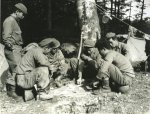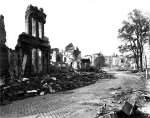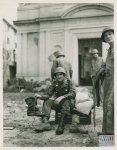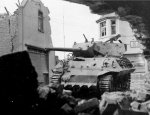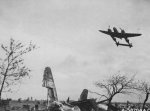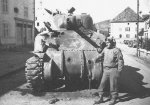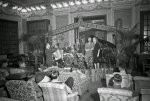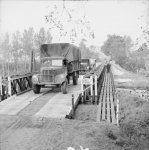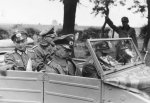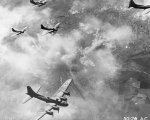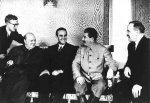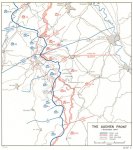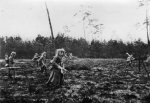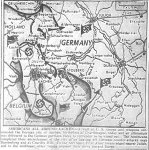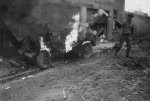October 6, 1944: Canadian 3rd Division and Canadian 2nd Corps (part of Canadian 1st Army) assault the German pocket at Breskena, Belgium (south of the Scheldt Estuary, between the Leopold Canal and the southern bank of the river around Breskens). The flooded terrain contributes to a lack of progress.To the north, Allied troops captured Ossendrecht, the Netherlands. US 1st Army continues attacking toward Geilenkirchen, Alsdorf, Baesweiler, and Schmidt and US 3rd Army is engaged at Fort Driant. Further south, US 7th Army attacks Vagney and French 1st Army is withstanding German counterattacks around Le Thillot.
Over northwestern Europe, RAF 2nd Tactical Air Force supports ground operations and flying sweeps and US 9th Air Force conducts operations in support of ground forces and attacks targets in Germany and the Netherlands.
Heavy air raids by the Allied air force are increased over Germany - they are able to send bombers day and night due to near-complete air superiority. The RAF’s primary targets are supply lines - particularly oil refineries. The RAF successfully bombs the synthetic oil plants in Gelsenkirchen and Oberhausen while 121 of 406 of the dispatched B-24s of the USAF’s Eight Air Force bomb the Harburg / Rhenania oil refinery (Harburg’s Phoenix tire plant was also targeted). The US 8th Air Force attacks Stargard airfield with 199 bombers, Stettin with 12 bombers, Neubrandenburg with 73 bombers, Straslund with 100 bombers, Hamburg with 289 bombers, Wenzendorf with 46 bombers, Berlin with 382 bombers, and targets of opportunity with 89 bombers. US 8th Air Force fighters attack five seaplane bases and claim 40 German seaplanes destroyed. During the day, RAF Bomber Command sends 320 aircraft to attack Sterkrade and Scholven/Buer the overnight, RAF Bomber Command sends 523 aircraft to attack Dortmund, 253 aircraft to attack Bremen, 22 aircraft to attack Berlin, and 13 aircraft to attack Ludwigshafen and Saarbrucken.
On the eastern front, Hitler refuses to allow German 16th Army and 18th Army to withdraw from positions around Riga. German 3rd Panzer Army is collapsing under assault by Soviet 1st Baltic Front. The Soviets begin the Debrecen offensive: Soviet 4th Ukrainian Front attacks the German 1st Panzer Army and 1st Hungarian Army in eastern Hungary while the Soviet 2nd Ukrainian Front attacks the German 6th Army, German 8th Army, and Hungarian 3rd Army in southern Hungary.
In Italy, British 8th Army begins attacking across Fiumicino River and US 5th Army attacks around Monte Vigese, Monte Stanco, Monte Caula, Castelnuovo di Bisano, La Villa, and Monte Ceco. Off the coast, US Navy destroyer Niblack bombards Cape Impeglio, then is damaged in an accidental collision with US Navy destroyer Jouett.
In Britain, the "blackout" is diminished to a "dim-out" as threat of invasion and further (piloted) bombing seems an unlikely possibility.
Pictured: Cpl R Young and Sgt GE Murray both of the Fort Garry Horse repairing the track, Sherman VC firefly tank, Putte, Netherlands, October 6, 1944.; Canadian Calgary Highlanders Sniping Platoon Sergeant H.A. Marshall cleans the telescopic sight of his No.4, MkI(T) rifle during a scouting, stalking and sniping course, Kapellen, Belgium, October 6, 1944.; Tegel district of Berlin October 6, 1944. The target is tentatively defined as the RHEINMETALL-BORSIG AG armored vehicle manufacturing plant. This photo was taken from the aircraft flown by LT Koonce of the 486th Group "B" (high squadron and 92nd CBW Group "D") flying as the #2 wing in the lead element. The camera was a K-21, with a f-stop of 7. The relative base altitude was 26,900 feet.; An American soldier shares his rations with two hungry Italian children, October 6, 1944.
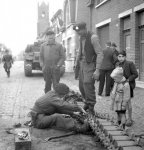
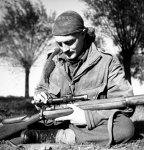
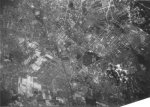
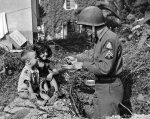
Over northwestern Europe, RAF 2nd Tactical Air Force supports ground operations and flying sweeps and US 9th Air Force conducts operations in support of ground forces and attacks targets in Germany and the Netherlands.
Heavy air raids by the Allied air force are increased over Germany - they are able to send bombers day and night due to near-complete air superiority. The RAF’s primary targets are supply lines - particularly oil refineries. The RAF successfully bombs the synthetic oil plants in Gelsenkirchen and Oberhausen while 121 of 406 of the dispatched B-24s of the USAF’s Eight Air Force bomb the Harburg / Rhenania oil refinery (Harburg’s Phoenix tire plant was also targeted). The US 8th Air Force attacks Stargard airfield with 199 bombers, Stettin with 12 bombers, Neubrandenburg with 73 bombers, Straslund with 100 bombers, Hamburg with 289 bombers, Wenzendorf with 46 bombers, Berlin with 382 bombers, and targets of opportunity with 89 bombers. US 8th Air Force fighters attack five seaplane bases and claim 40 German seaplanes destroyed. During the day, RAF Bomber Command sends 320 aircraft to attack Sterkrade and Scholven/Buer the overnight, RAF Bomber Command sends 523 aircraft to attack Dortmund, 253 aircraft to attack Bremen, 22 aircraft to attack Berlin, and 13 aircraft to attack Ludwigshafen and Saarbrucken.
On the eastern front, Hitler refuses to allow German 16th Army and 18th Army to withdraw from positions around Riga. German 3rd Panzer Army is collapsing under assault by Soviet 1st Baltic Front. The Soviets begin the Debrecen offensive: Soviet 4th Ukrainian Front attacks the German 1st Panzer Army and 1st Hungarian Army in eastern Hungary while the Soviet 2nd Ukrainian Front attacks the German 6th Army, German 8th Army, and Hungarian 3rd Army in southern Hungary.
In Italy, British 8th Army begins attacking across Fiumicino River and US 5th Army attacks around Monte Vigese, Monte Stanco, Monte Caula, Castelnuovo di Bisano, La Villa, and Monte Ceco. Off the coast, US Navy destroyer Niblack bombards Cape Impeglio, then is damaged in an accidental collision with US Navy destroyer Jouett.
In Britain, the "blackout" is diminished to a "dim-out" as threat of invasion and further (piloted) bombing seems an unlikely possibility.
Pictured: Cpl R Young and Sgt GE Murray both of the Fort Garry Horse repairing the track, Sherman VC firefly tank, Putte, Netherlands, October 6, 1944.; Canadian Calgary Highlanders Sniping Platoon Sergeant H.A. Marshall cleans the telescopic sight of his No.4, MkI(T) rifle during a scouting, stalking and sniping course, Kapellen, Belgium, October 6, 1944.; Tegel district of Berlin October 6, 1944. The target is tentatively defined as the RHEINMETALL-BORSIG AG armored vehicle manufacturing plant. This photo was taken from the aircraft flown by LT Koonce of the 486th Group "B" (high squadron and 92nd CBW Group "D") flying as the #2 wing in the lead element. The camera was a K-21, with a f-stop of 7. The relative base altitude was 26,900 feet.; An American soldier shares his rations with two hungry Italian children, October 6, 1944.




Last edited:


